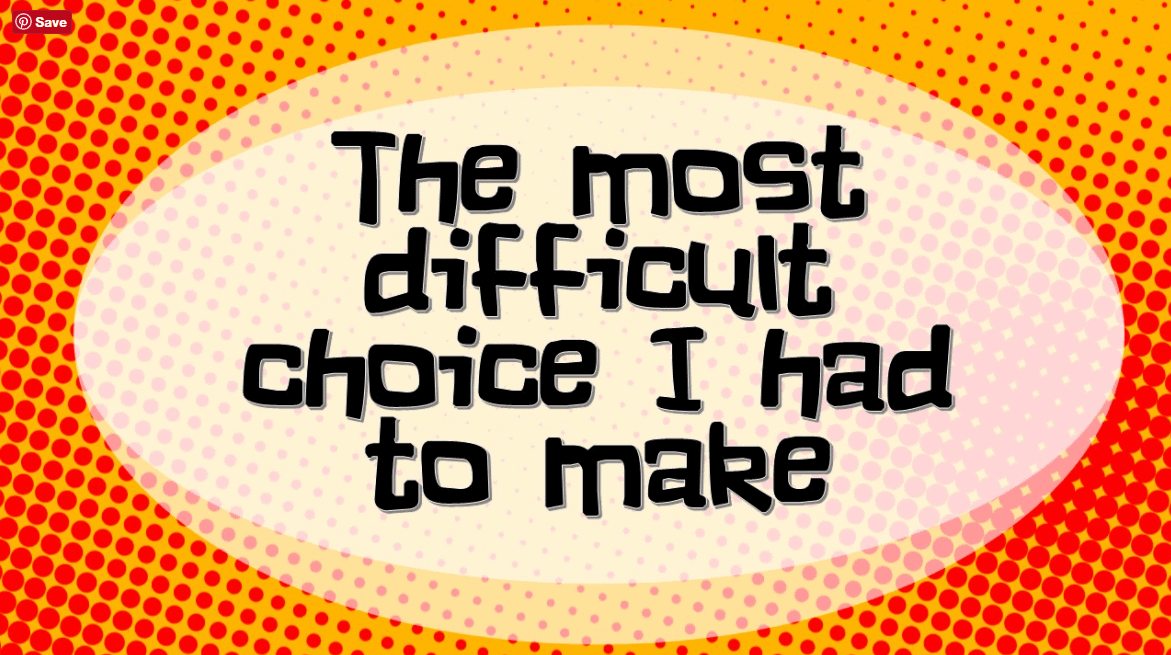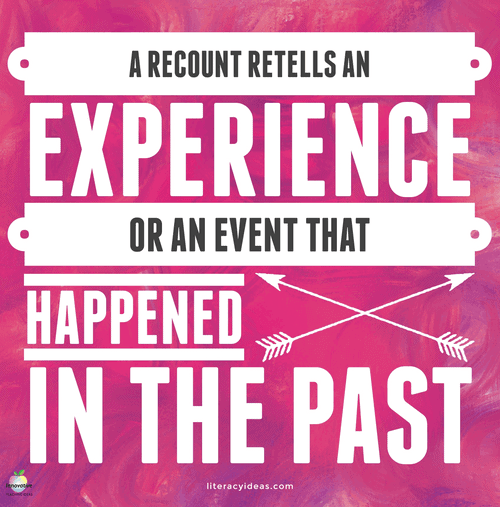
Our students encounter recounts in many shapes and forms.
From factual recounts in the form of newspaper reports, historical documents, and biographies to imaginative A Day in the Life of-type recounts and recounts based on personal experiences, this is a very diverse text type.
Luckily, despite the wide variety of recount categories, they each share some standard features that, once learned, our students can confidently produce their own versions of the different recount types.
In this article, we’ll take a whirlwind trip through all the stages our students need to master to produce a well-written recount.
You’ll take your students from defining a recount’s purpose through its planning and preparation and on to the writing and final editing process.
So, without more ado, let’s get started on How to Master Recount Writing in a Single Week.
RECOUNT WRITING LESSON PLANS
Day 1: The Purpose of a Recount
Before students can begin to produce their own recount texts, they’ll need to have a clear grasp in their minds on the exact purpose of that recount is. This is better demonstrated than explained.
A fun way to demonstrate the purpose of a recount to your class is to play the game Two Truths and a Lie with them.
To do this, ask the students to think of two fantastic things they have done. They should write these down secretly on a piece of paper.
Now, ask the students to make up one thing they haven’t done. They should add this to their secret list too.
The students then jumble up the order and take turns reading their list to the class. The class must attempt to identify the ‘lie’ by taking a vote a class vote.
Play this game for a few rounds and then explain to the class that they have just been writing recounts; two are factual, and one is fictional. Inform your students that recounts retell experiences or events from the past.
The Types of Recounts
Recounts come in many different forms. Ask your students to identify as many different types of recounts as possible. If the school library is available, perhaps you could challenge them to browse the texts to identify as many distinct types of recounts as possible.
Alternatively, you could provide a selection of different recount texts for the students to sort and categorize in class. Some common recount types include:
● Diaries
● Autobiographies
● Letters
● Trip Reports
● Historical Reports
● Newspaper Reports
● Witness Statements
Spend some time discussing the different purposes of the various texts. Relate the purpose to the title of each text. Generally, a recount’s primary focus is encapsulated in the title, e.g. My First Day at College, An Eventful Trip to Madagascar, An Accident on Highway 6, etc.
To get some practice at writing titles that sum up the main focus, finish today’s session by asking students to write titles for the two truths and one lie they wrote for the activity earlier. They can share and discuss these at the end.
A COMPLETE UNIT ON TEACHING RECOUNT WRITING
MASTER RECOUNT WRITING with this complete EDITABLE UNIT that ensures your students learn how to retell events with accuracy and energy. covering PERSONAL, FACTUAL, LITERARY and HISTORICAL RECOUNTS.
Teach your students to write AMAZING RECOUNTS in various styles with this COMPLETE 78 PAGE UNIT. No preparation is required.
Day 2: The Structure of a Recount

Now your students have a clear sense of the purpose of recounts, they’ll need to become thoroughly familiar with the main features and foibles of this text type – and that’s where Day 2 comes in!
Though your students will be aware at this stage that there are many different types of recount, they must understand that a generic structure is underlying all of these.
Essentially, there are four questions that students will need to answer in their recount, no matter what type they’re writing. We can refer to these as The Four Pillars of a Recount. These pillars are:
- Who? Who are the main participants/characters in the recount?
- Where? Where did the events happen?
- When? When did the events happen?
- What? What happened?
One activity that can help get your students to think about these four pillars is organising them into pairs and providing them with some sample texts. They can then work together to identify the answers to the four ‘pillar’ questions. These they can then present to the class.
We can further organize recounts into three main sections:
- The Orientation
- The Events
- The Conclusion
Writing The Orientation of a Recount
In the orientation or introduction, the student sets the scene for the reader regarding characters, setting, and context. The orientation will provide the reader with all the necessary background details to understand what the recount is about. It answers three of the four pillar questions, e.g., Who? Where? and When?
Writing The Events within a Recount
In the body paragraphs of a recount, significant events are related in a chronological sequence, that is, in the order they happened. This section, usually the longest of the three sections, answers the fourth pillar question, i.e., why?
Getting students to draw up timelines of recent events in their lives can be a helpful way to illustrate the concept of chronology.
Writing The Conclusion of a Recount
Explain to the students that a recount conclusion comes at the end and usually contains a final evaluative comment on the writer’s thoughts or feelings about the events or experience described. This is where the writer makes any personal comment, opinion, or interpretation of the events.
It can be helpful at this point to ask students to identify where the conclusion begins in several different recount texts by identifying the features of a conclusion as described in the previous paragraph.
You could also encourage the students to write their own brief conclusions for the Two Truths and a Lie paragraphs they wrote in the previous activity, including an evaluative comment on how they think or feel about the event – the two factual ones!
Day 3: The Features of a Recount
So far, our students have been looking at recounts in rather broad strokes. Now, it’s time to drill down in more detail and examine the genre’s specific language features.
Firstly, by its very nature, the events described in a recount have already happened, so the fact that they are written in the past tense should be evident to our students. Once students understand this, it will help them identify the correct verb form for their writing.
To reinforce this, you might give students some photocopies of recounts and ask them to work in small groups to highlight all the verbs in the past tense they can identify.
When writing recounts, verbs are what drive the action. Students should take the time to select the most suitable verb for the job at hand. Thesauruses can be handy tools to help here.
As the students begin to organise the chronology of the events in their recounts, time connectives such as first, then, next, etc., are used to help sequence the text’s body paragraphs.
There are numerous time connectives for students to familiarise themselves with. It’s worth taking the time to brainstorm as many of these as possible, working together as a class. Compile them all into a comprehensive master list of time connectives such as:
- First
- Then
- Next
- After that
- Before
- Finally, etc.
When the class has done this, they are now perfectly primed to write a paragraph or two relating their experiences from yesterday’s Two Truths and a Lie game in a little more detail and the form of a recount.
To do this, have the students use the timelines they drew up yesterday and their list of connectives.
One final language feature for students to consider is their use of nouns. To clarify their writing, students should be as specific as possible when choosing words to identify people, places, times, and events.
This means opting for proper nouns where at all possible. For example, instead of writing ‘the ocean’, encourage the student to name the ocean, e.g., ‘the Pacific Ocean. Rather than write ‘the girl’, use her name or job title.
Less obviously, common nouns such as ‘car’ can be replaced by the model (e.g. Ford Focus) and where substitution with particular brand names and models isn’t an option, encourage students to get more specific by adding a few well-chosen adjectives.

CLICK HERE TO SEE OUR FREE RECOUNT WRITING PROMPTS
Day 4: Planning and Preparation
The purpose, structure, and features of the recount are securely in the bag; it’s time for students to plan and prepare to write their own.
You could give your students free rein to write a recount on a topic of their choosing. However, restricting their choice in this instance will provide them with one less thing to focus their energies on, leaving the way clear to focus on the writing alone.
Trips are often a rich vein to tap when it comes to recount writing, and in recent times, virtual trips are all the rage due to the worldwide pandemic. You can find a selection of possibilities for virtual trips on this YouTube playlist here: Virtual Field Trips.
Choose a video suited to your class’s age and ability and your preference of video style – some are text-based, and most have voice-overs. You might even be able to create some cross-curricular links by choosing a topic related to your student’s work in the social sciences, geography, etc.
Students should watch the video carefully, taking lots of notes as they do so as these will form the basis of their recount.
To help students plan their writing, encourage them to use a mind map. One way to organize their mind map is to write the topic of the recount in the centre of the page and then create branches to answer the following questions:
- What happened?
- When did it happen?
- Where did it happen?
- Who was involved?
- Why did it happen?
- How did it happen?
When the students have finished their mind maps, ask a few volunteers to share their work and discuss it as a class. A mind map such as this is a fantastic planning tool that will make the writing process much smoother for the student.
Once students have completed their mind map, they can then organise their information into the structure of a recount using a graphic organiser using the headings of:
- The Orientation
- The Events
- The Conclusion
Now, with prep and planning in hand, it’s on to Day 5 on the road to recount mastery!
Day 5: Extended Writing
In today’s lesson, students will get stuck into writing their recounts in earnest. Make sure you have enough time set aside for them to complete their draft. For older or higher-ability students, this might mean completing the writing at home over the weekend.
To get started, have a quick question and answer session to review the features and structure of a recount orally. If time allows, this might take the form of compiling a checklist of recount criteria on the whiteboard that the students can refer to during the writing process.
Sometimes it’s a good idea to set a specific time or length limit for the recount, particularly if you want to ensure they complete their piece within a single class. For example, you might inform students that they have 40 minutes to finish their recount or that they MUST finish their recount within a single A4 page.
Remind students to refer to their mind maps, graphic organisers, and criteria checklist as they write their recounts.
If they finish early, they should check their work for grammar, sentence structure, and punctuation.
Fine Tuning
On completing the activities above, your students should have a firm, comprehensive grasp of the main elements of recount writing.
Once your students have woven these elements together to create their own recount, some opportunities should be provided to improve their initial draft. This may take the form of teacher feedback or peer assessment.
Reinforce to your students that writing isn’t a ‘one and done’ process. Becoming a master of recount writing will require editing and proofreading to become a crucial part of the process.



